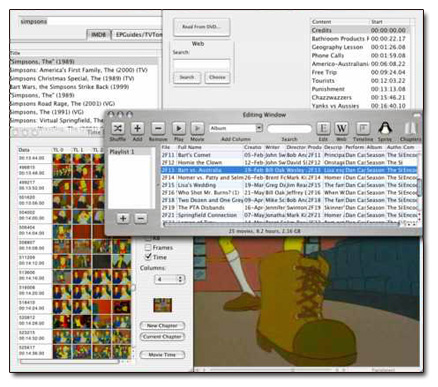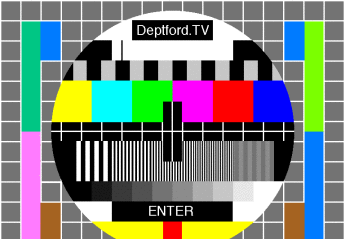In the week of the 2nd of June the Bitnik media collective visited Deptford.TV at Deckspace and the second TV Hacking session was held together with people from the Hacklab, PureDyne, OpenStreetMap and Boundless projects.
We discussed the editing and publishing systems of Deptford.TV. The decision is to design a memory stick on which all the production software is installed so that every contributor can use any computer connected to the internet.
Therfor the Dynebolic system using Cinelerra is ideal. For the distribution bitinik wants to release the copyfight as an installer towards march next year. Hopefully by the next Node.London session (if there will be one) Deptford.TV can present the system flow running from production to distribution on FLOSS systems.
For Deptford X in November Deptford.TV plans to hold mini DIY soldering TV transmitter workshops on the concept & idea of the hut project, see similar project on radio transmitters presented at Briklane in the same week, from the hut project website:
Dispersed Radio Network / FM Transmitter Workshops

On the 1st of June 2006, from a location on Brick Lane, The Hut Project made the first in an ongoing series of public radio broadcasts, beginning the first leg of our Dispersed Radio Network project. Over a four-day period, our broadcast, covering a 2-mile radius, invited listeners to come to a micro-FM transmitter workshop. We have mappped the location of every transmitter that was built during this first workshop event, and will be asking everyone who built a transmitter with us to take part in a simultaneous broadcast in the next month. Our broadcasts will now be spreading out across London, the UK and wherever we else we get to, as and when the opportunity arises, allowing participants to construct their own micro-radio transmitters, and broadcast their own programmes to their homes, buildings, and streets. At intermittent periods, as we request that all those whio have taken part in our project take part in simultaneous broadcasts, we will be creating, momentarily, a dispersed micro-radio network. We will soon be publishing the map of transmitter locations on this site, and we’ll announce the times of any broadcasts by the network. An archive of all the material broadcast by the network will be stored here as and when it develops.
for the metadata editing we will try out the meta data hootenany, what a name! quoted from metadata hootenany:
Metadata Hootenanny
This is a page about my latest piece of clever software: Metadata Hootenanny.
What Is It? It’s a viewer/editor for all the spiffy metadata you can put into ![]() QuickTime movies. You know how you can view, edit and sort by your mp3s’ ID3 metadata in iTunes? Well, a similar metadata system exists for all your QuickTime movies, too, but until now the only way to access it was through the horrid interface of QuickTime Pro Player (You can see certain metadata items in QT’s Info window, and add them in the Movie Properties window under Annotations).
QuickTime movies. You know how you can view, edit and sort by your mp3s’ ID3 metadata in iTunes? Well, a similar metadata system exists for all your QuickTime movies, too, but until now the only way to access it was through the horrid interface of QuickTime Pro Player (You can see certain metadata items in QT’s Info window, and add them in the Movie Properties window under Annotations).
Metadata Hootenanny lets you access this information more easily (and for free!). You can make a playlist of all the videos in your collection with a certain director or writer. You can search your videos for a certain performer, or a keyword in the description. Of course, you have to add all this information to your movies yourself…which is a breeze with Metadata Hootenanny.
Why Would I Ever Want To Have Metadata in My Movies? Ok, ok. Most people probably don’t care about movie metadata yet. The best use I see for this program is for people (like me) who have large collections of TV shows or music videos, somewhat short movies that might conceivably be played back-to-back, or collected into small lists based on subordinate criteria, as might be stored in QuickTime movies’ metadata tags (like writer, director, author, album, etc).
What Kind of Metadata Are We Talking About Here? The Program supports all the Annotations that Quicktime uses (Album, Artist, Author, Comment, etc). Custom categories can be used as well, if they are four characters long and starting with ‘©‘, like “©CMT.” You can type a © in MacOS with option-g. In Addition, there are (mostly) read-only properties about the movies, like video/audio formats, file size, and movie length. Finally, it lets you add or edit Chapter Tracks, which are a cool little feature of the QuickTime container format that is seldom used. They’re like little bookmarks in the movie with a popup-menu that lets you jump between them. In QuickTime Pro, in order to make a chapter track, you have to create a text file formatted in a certain way, with timepoints you must type out by hand, then import it to QuickTime, add it to your movie, un-enable it, and set it as a chapter track.
My way is much easier, trust me, plus if you have a problem or better yet a suggestion, I will be happy to fix it for you. And in case you feel nostalgic for the QTPlayer way, Metadata Hootenanny exports chapter lists to the QuickTime text format, ready for import.
That’s Fine, But What Else Does It Do? I’m glad you asked. In addition to adding metadata and chapters, you can also add DVD-style interactive menus, using QT’s wired sprites. Menu buttons can have images from image files or from the movie itself, and have rollover and on-click pictures as well. Button actions include going to a certain chapter, enabling audio or text (subtitle) tracks, and stepping forward or backward.
Other features include integrated www lookup with IMDB.com, EPGuides.com, TVTome.com and BlockBuster.com, and reading of chapter times directly from the DVD drive or from other movie files. Also movie playback features like fullscreen and rate control.
USE AT YOUR OWN RISK, although little risk is really involved. The program never even tries to write to the original files (unless of course you choose the unrecommended “save-in-place” option from the save-as window); it only creates new files [NOTE: an unexpected “feature” of the QuickTime API had lead to version 1.0 modifying input files when chapters are added. It is fixed in the “unstable beta” version] I don’t know what it would do if you ran out of hard drive space, though….
Download
unstable beta (check out the version notes and latest beta changes in News + History)
source code (I have a sourceforge project but apparently I’m not competent to use their cvs, so if someone who is wants to upload the source let me know and I’ll add you as a dev on the project)
Here is the source code of what I’m working on for the next version. It has some interesting new stuff, and just about everything is broken in some way. Since I don’t anticipate having much time to fix it, I encourage you to mess around with it in any way you like.
Please email me with any bugs you find and I will fix them toute suite. You can also receive prompt technical support by visiting the ![]() 3ivx forums.
3ivx forums.
Here’s a little picture of it






